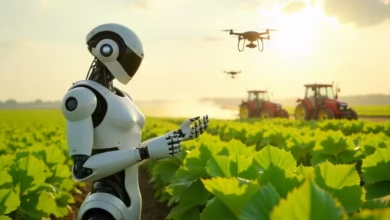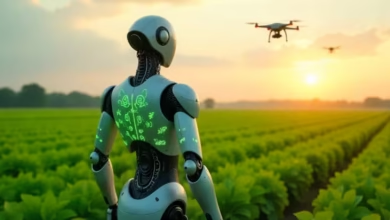AI-Powered Renewable Energy Optimization: Shaping A Greener Future

A World Powered by Intelligence and Sunlight
Imagine a city where the lights never flicker, even when clouds hide the sun or winds suddenly die down. Behind the scenes, algorithms predict energy demand, reroute solar and wind power, and store just enough battery energy to keep everything stable. This is not science fiction—it’s happening today through AI-powered renewable energy optimization.
As the world races against climate change, AI is stepping in as a critical tool to make clean energy not just possible, but reliable and scalable. From predicting weather patterns to fine-tuning energy grids, artificial intelligence is quietly revolutionizing the renewable sector. And in doing so, it is reshaping how we think about sustainability, resilience, and the future of our planet.
The Role of AI in Renewable Energy: Why Optimization Matters
Traditional power grids were designed for coal and gas plants—steady, predictable sources. Renewable energy, however, is variable. The sun sets, the wind stops, and energy flows become uncertain. Without optimization, integrating renewables into the grid is like trying to balance on shifting sands.
This is where AI-powered renewable energy optimization shines. Machine learning algorithms can:
- Predict solar and wind output with astonishing accuracy.
- Adjust grid operations in real-time.
- Balance energy storage and consumption.
- Reduce waste and cut emissions.
The International Energy Agency (IEA) notes that AI-driven forecasting improves solar energy prediction accuracy by up to 30%, helping utilities plan ahead and avoid blackouts (source).
Smarter Grids: AI as the Brain of Energy Systems
Think of the energy grid as a living organism. Electricity pulses through it like blood, while demand surges and dips like a heartbeat. AI acts as the brain, constantly analyzing data from millions of sensors to keep everything balanced.
For example:
- In Denmark, AI is used to manage wind energy, ensuring that sudden gusts don’t overwhelm the grid.
- Google’s DeepMind cut energy use in its data centers by 40% using AI optimization—proof that small improvements add up to massive savings (Google Sustainability Report).
These smart grids powered by AI are not just efficient; they are adaptive, learning from each moment to perform better tomorrow.
Wind and Solar Farms: Where AI Meets Nature
A wind farm may look calm, but it generates a storm of data—wind speed, turbine rotations, energy output. Similarly, solar farms track sunlight angles, cloud cover, and panel efficiency. AI turns this data into action:
- Predictive Maintenance: AI predicts when turbines or panels are likely to fail, saving millions in repairs.
- Optimal Tilt & Rotation: Algorithms calculate the perfect angle for solar panels to capture every possible ray of light.
- Performance Monitoring: AI spots underperforming equipment instantly, ensuring maximum energy capture.
A study by MIT Technology Review showed that predictive AI systems in wind farms can increase output by 20% while cutting downtime.
AI-Powered Energy Storage: Solving the “Dark Night” Problem
One of the greatest challenges in renewable energy is storage. What happens when the sun sets or the wind stops? Batteries are the answer, but without smart management, they can be inefficient and costly.
AI algorithms balance when to charge and discharge batteries, much like a skilled conductor leading an orchestra. For instance, Tesla’s Autobidder system uses AI to optimize battery trading in energy markets, ensuring stability while maximizing revenue.
This ability to predict and act transforms energy storage from a weak point into a powerhouse of reliability.
Case Studies: Real-World Success Stories
- Australia’s Hornsdale Power Reserve – The world’s largest lithium-ion battery, powered by Tesla, uses AI to stabilize the grid. It prevented blackouts and saved $150 million in costs within its first two years.
- Spain’s Iberdrola – This energy giant applies AI to monitor over 1,200 wind turbines. The result: reduced maintenance costs and higher efficiency.
- California’s Smart Grid – AI predicts solar output across thousands of rooftops, feeding stable electricity into a grid serving millions of people.
These are not isolated cases—they are blueprints for the future.
The Challenges of AI in Renewable Energy
Of course, it’s not all sunshine and wind. Several challenges remain:
- Data Security: Energy systems are prime targets for cyberattacks.
- Cost Barriers: Implementing AI requires heavy upfront investment.
- Bias in Algorithms: Poor data can lead to flawed predictions.
- Job Disruption: AI automation may shift roles in energy industries.
These hurdles remind us that while AI-powered renewable energy optimization is transformative, it is not a silver bullet. Governance, ethics, and collaboration remain essential.
The Human Side: Building Trust in AI Energy
Imagine a homeowner who installs solar panels. They trust the system to lower bills and help the planet. But if AI mismanages storage or fails during a heatwave, trust erodes.
That’s why transparency is vital. Companies must explain how AI makes decisions, involve communities in planning, and ensure human oversight. AI should not replace human judgment—it should amplify it.
Looking Ahead: AI as a Partner for a Greener Tomorrow
So, where does this leave us? The future is clear: AI is not just optimizing energy—it’s redefining sustainability itself. From predicting weather to managing batteries, it is the hidden force making renewables reliable.
But we must remember: AI is a tool, not a savior. Its success depends on how wisely we use it. The real challenge is not building smarter machines but fostering smarter societies that know how to integrate them.
As global demand for clean energy rises, AI-powered renewable energy optimization will likely become as essential as the sun and wind themselves. And in that partnership between nature and intelligence, lies the hope of a greener, more resilient world.
For similar articles, please visit: AI in Environment & Sustainability
Homepage / humanaifuture.com




